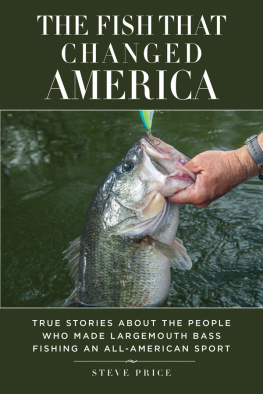 The Freshwater Angler
The Freshwater Angler THE BIG BOOK OF
BASSSteve Hauge


Copyright 2008
Creative Publishing international, Inc.
400 First Avenue North, Suite 300
Minneapolis, MN 55401
1-800-328-3895
www.creativepub.com
All rights reserved
President/CEO: Ken Fund
VP for Sales & Marketing: Kevin Hamric
Publisher: Bryan Trandem
Acquisitions Editor: Barbara Harold
Editor: Jennifer Gehlhar
Authors: Steve Hauge, Jim Moynagh, Don Oster, Dick Sternberg
Production Managers: Laura Hokkanen, Linda Halls
Creative Director: Michele Lanci-Altomare
Senior Design Managers: Jon Simpson, Brad Springer
Design Manager: James Kegley
Cover Design: Greg Nettles
Book Design: Emily Brackett
Page Layout: Greg Nettles
Printed in China
10 9 8 7 6 5 4 3 2 1
Digital edition: 978-1-61673-369-8
Softcover edition: 978-1-58923-407-9
Library of Congress Cataloging-in-Publication Data
Hauge, Steven.
The big book of bass : strategies for catching largemouth and smallmouth / Steve Hauge.
p. cm. -- (Freshwater angler series)
Includes index.
Summary: Comprehensive strategies for catching both largemouth bass and smallmouth bass. Also discusses habitat and fish behavior. Detailed how- to photography shows how to put the information into practice.
Index--Provided by publisher.
ISBN-13: 978-1-58923-407-9 (soft cover)
ISBN-10: 1-58923-407-3 (soft cover)
1. Bass fishing. I. Title. II. Series.
SH681.H34 2008
799.1773--dc22 2008007058
All rights reserved. No part of this work covered by the copyrights hereon may be reproduced or used in any form or by any meansgraphic, electronic, or mechanical, including photocopying, recording, taping of information on storage and retrieval systemswithout the written permission of the publisher.
CONTENTS
INTRODUCTION

American anglers pursue largemouth and smallmouth bass more than any other freshwater gamefish. The main reason: bass fishing is exciting. Once you experience the head-shaking leap of a largemouth or bulldogging run of a smallmouth, chances are you will come back for more.
One measure of the bass appeal is the huge number of anglers that belong to tournament bass-fishing organizations, such as the Bass Anglers Sportsman Society and FLW outdoors.
Most of these fishermen can find bass within a short drive from home. Both species are found in waters from central Canada to Mexico. They live in muddy rivers and crystal-clear lakes, tiny golf courses, ponds and 100-mile-long reservoirs, knee-deep sloughs, and even brackish coastal estuaries alongside saltwater fish.
The purpose of The Big Book of Bass is to make you a better bass fisherman. It leads you through the world of the largemouth and smallmouth bass fishing with clear, concise text and spectacular color photographs.
The first requirement for catching bass is understanding the fish themselves. This book explains every important aspect of largemouth and smallmouth behavior based on input from prominent bass anglers and biologists throughout the country. The first section will focus on the largemouth bass, followed by an equally informative section on the smallmouth bass. You will discover how bass detect food, what they eat, when they are likely to feed, and how to use this knowledge to catch fish.
In most waters, only a small fraction of the acreage contains bass. To catch bass consistently, you must know where to look at different times of the day and year and under different weather conditions. The equipment sections will help you select everything from boats and motors to rods and reels. Not everyone needs a high-powered bass boat; sometimes a small, portable boat or float tube works better. But a serious bass fisherman should own a locator and know how to use it in conjunction with a mapping GPS unit. Well show you how to do that.
Many bass fishermen know how to catch bass in their favorite lake when conditions are right. But if the weather changes or if they try a different lake, they fail to make the necessary adjustments. The last section of the book, Advanced Bass Fishing, will teach you how to use numerous proven techniques for catching largemouth and smallmouth bass, plus it includes little-known secrets used by the countrys bass experts.
Whether you do most of your fishing in tiny farm ponds or sprawling reservoirs, whether you are a beginner or a veteran, this book is sure to improve your bass-fishing skills.
LARGEMOUTH BASS

Chapter 1
THE LARGEMOUTH BASS

Renowned for its explosive strikes and spectacular leaps, the largemouth bass is a favorite among millions of freshwater fishermen.
Largemouth were originally found only east of the Mississippi River and south of the Great Lakes. But as bass fishing grew in popularity, so did stocking programs in many states. Largemouth are now caught in waters throughout the continental United States and Hawaii, in addition to Canada and most of Mexico. Bass have been introduced in Europe, Asia, Africa, and South America.
The largemouth bass is the largest member of a group of closely related fishes called black bass. Others include the smallmouth, spotted, redeye, Suwannee, and Guadalupe. The largemouth is distinguished from all of these species by a jaw that extends beyond the eye. All black bass belong to the sunfish family, but differ from sunfish because of their longer bodies.
Biologists have identified two subspecies of largemouth bass: the Florida largemouth and the northern largemouth. Originally, Florida bass lived only in Florida waters. Stocking efforts have expanded their range to include much of the South, particularly Texas and California.
Although they look alike, the Florida largemouth grows considerably larger than the northern subspecies. A trophy Florida bass weighs from 10 to 20 pounds (4.5 to 9 kg), compared to 6 to 8 pounds (2.7 to 3.6 kg) for a northern largemouth bass.
Some biologists believe that the world record largemouth bass was a cross between the northern and Florida subspecies. The 22-pound, 4-ounce (10 kg) largemouth was caught in June, 1932, at Montgomery Lake in Georgia. This lake is one of many waters in Georgia and Alabama where largemouth crosses have been found.
LARGEMOUTH BIOLOGY

Largemouth bass vary in color, depending upon the type of water. Bass from murky waters are pale, while those from clear waters are darker. Largemouth range from deep green to pale olive across the back, with bellies that are a shade of white or yellow. All bass have a black lateral band that runs from the head to tail. The band becomes more distinct when a fish is exposed to sunlight, but may disappear when a largemouth is in deep or murky water.










 The Freshwater Angler
The Freshwater Angler




